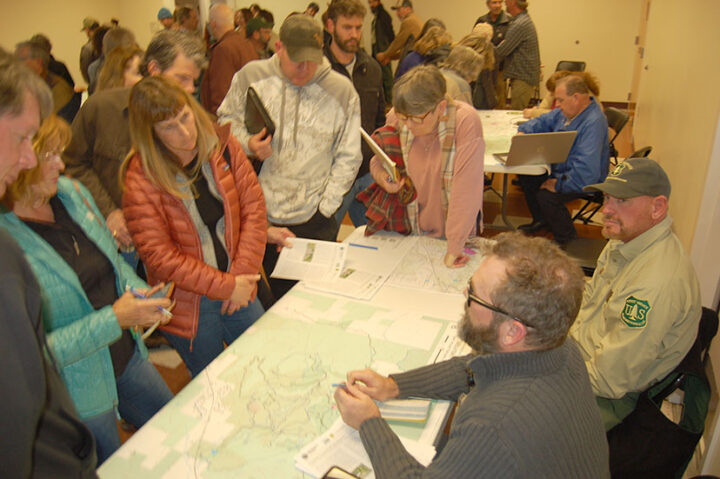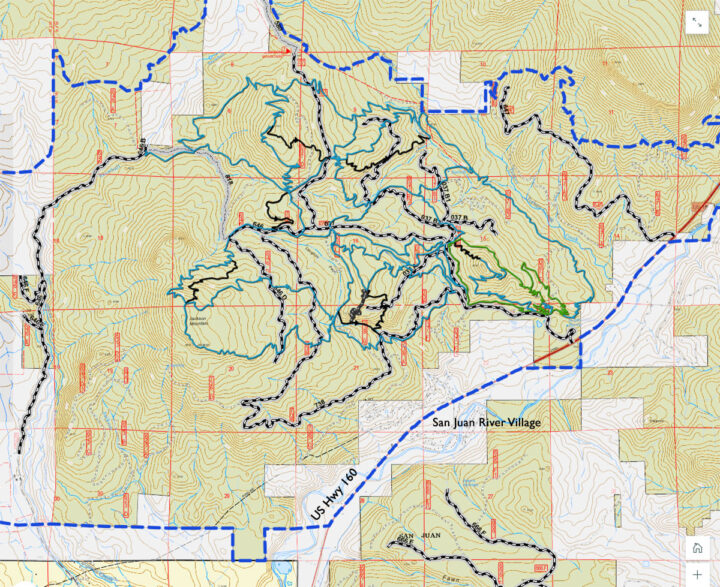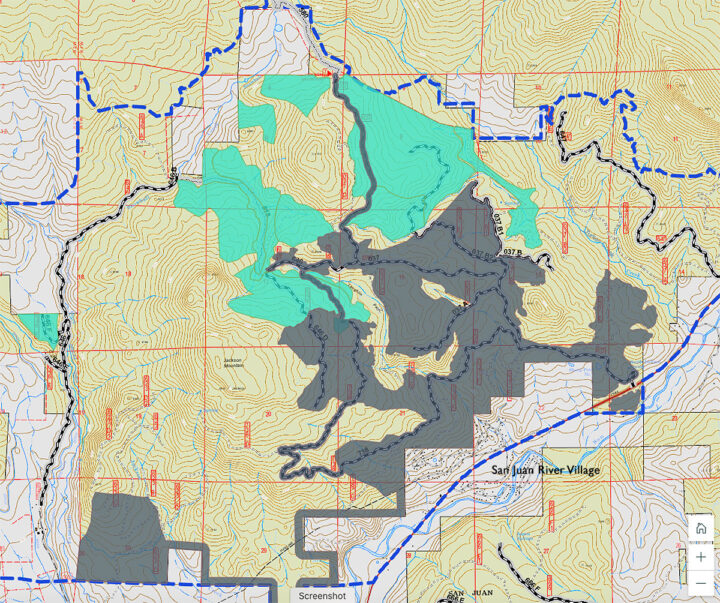landscaping
transitive verb
: to modify or ornament (a natural landscape) by altering the plant cover
intransitive verb
: to engage in landscape gardening
— from the Merriam-Webster Dictionary
Last month, the San Juan National Forest posted a notice announcing a “Public Scoping Period for Jackson Mountain Landscape Project Open Until February 23, 2023”.
Not “landscaping” in the typically suburban sense of the word, however. The potential work on Jackson Mountain, just north of the San Juan River Village subdivision — about five miles north of downtown Pagosa Springs — would alter the landscape within a project area measuring about 10,000 acres.
The number “10,000” is a rough guess on my part, but it’s close to an estimate from the Forest Service.
The public is invited to give input on the proposed project, through February 23, written or via a website.
The U.S. Forest Service — specifically, the San Juan National Forest administrative team — hosted an in-person ‘open house’ last Thursday at the Ross Aragon Community Center on Hot Springs Boulevard, and attracted a crowd of several dozen interested citizens.
From what I could tell, the citizens at the scoping event generally came in two flavors. ‘Recreationalist’ and ‘suburban homeowner’.
One group had come to learn more about the proposed trail system — up to 40 miles of mountain biking trails, ranging from ‘easy’ to ‘experts only’, plus some new parking and restroom areas. The ‘landscape’ area already includes a network of old logging roads, left over from timber operations back in the 1960s and 1970s, and it sounds like those logging roads would be opened up — or maybe, ‘remain open’? — to ATVs, Jeeps, and snowmobiles.
You can see the logging roads as dashed black-and-white lines in the Forest Service map below. The solid black lines are proposed ‘expert’ bike trails; the blue lines are ‘intermediate’ bike trails; the green lines are ‘easy’ bike trails. (I assume these also serve as ‘hiking trails’).
You can click the map for a larger version.
The other group came to question the plan for a proposed 13-acre gravel mine, to be located 700 yards or so from some of the suburban homes in the San Juan River Village subdivision. The mine has been proposed by the Archuleta County government, and would include a crushing operation.
We’ll have a more ‘in-depth’ gravel pit discussion tomorrow in Part Two.
Some of the San Juan River Village residents were expressing an interest, as well, in a potential 3,000-acre logging and ‘landscaping’ operation. Click to enlarge.
The maps I’m sharing are available in an interactive version online, here.
The ‘landscaping’ of Jackson Mountain — beyond the bike trails and gravel pit — could consist of “thinning, mowing, mastication, and tree harvests.” Presumably, we are talking here about some logging truck traffic, but as to the number and frequency, I don’t yet have any information.
Fuels treatments such as mowing, mastication, chipping, and hand thinning are being considered on up to 2,000 acres, and would reduce density of shrub species and smaller trees to “provide conditions where fire can move naturally on the landscape, and give fire managers more opportunities to safely manage fires in the area.” Another 1,000 acres are being considered for logging.
The pine and mixed-conifer forests in Archuleta County are — theoretically — adapted to regular wildfire events, with some studies suggesting that non-catastrophic fires occurred naturally every ten or twenty years… prior to the arrival of the U.S. Forest Service and its fire suppression policies, starting in 1905. For most of the 20th century, federal, state and local agencies prioritized fire suppression over prevention, pouring billions of dollars into hiring and training firefighters, buying and maintaining firefighting equipment, and posting Smokey the Bear posters in prominent locations. That policy has unfortunately resulted, now in the 21st century, in ‘unnatural’ forests that suffer from ever larger, and ever more destructive, fires.
Many forestry experts now argue that it’s long past time to shift the focus to creating ‘natural’ forests that can better withstand wildfire events, especially in the American West. Which is not to suggest that the general public has eagerly embraced this approach.
In the case of Jackson Mountain, some of the work will be aimed at ‘reviving’ aspen groves that have — again, due to fire suppression? — fallen into unhealthy decline.
Thinning the San Juan National Forest is difficult, unless you have a way to use, or dispose of, the cut timber. Archuleta County was once home to a thriving wood products industry; at one point in the late 1960s, the lumber mills accounted for about one-quarter of the employment here. Then, one by one, the mills closed, for various reasons. But the forest continued to grow.
From the San Juan Headwaters Forest Health website:
Growing populations and past forest management practices have interrupted patterns of periodic fire in the region, while a lack of local wood products industry has made it challenging to use industry as one of many tools available for actively managing forest health. These realities generate ecosystem responses that make our forests more susceptible to disease, insects, and high severity wildfire…
As mentioned, the Archuleta County government has expressed interest in opening a non-commercial gravel pit in the Jackson Mountain area to provide a local source of material for use on County and Forest Service roads. Reportedly, the rock found at the 30-acre site meets CDOT specifications. About 13 acres of the 30-acre site would actually be mined, if the project is approved.
More about the gravel pit in Part Two.
An Interactive StoryMap page showing the location of the proposed trail system, areas being considered for fuels and vegetation management, and the proposed gravel pit is available here.
For more information about this proposal, you can contact:
- Recreation – Paul Blackman, (970) 264-1505, or paul.blackman@usda.gov
- Vegetation/Fuels Management – Adam Tlachac, (970) 264-1513, or adam.tlachac@usda.gov
- Gravel Pit – Jamie Blair, (970) 560-6630, or james.blair2@usda.gov
To submit comments on the project, go to this website and click on “Comment/Object on Project”.
Hardcopy input can be mailed via United States Postal Service (USPS) or sent via courier (UPS/FedEx) to:
Pagosa Ranger District – Jackson Mountain project
180 Pagosa Street
PO Box 310
Pagosa Springs, CO 81147





